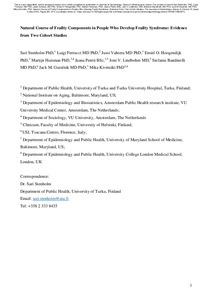Natural Course of Frailty Components in People Who Develop Frailty Syndrome: Evidence From Two Cohort Studies
Vahtera J; Hoogendijk EO; Bandinelli S; Huisman M; Ferrucci L; Stenholm S; Guralnik JM; Lindbohm JV; Kivimäki M; Pentti J
Natural Course of Frailty Components in People Who Develop Frailty Syndrome: Evidence From Two Cohort Studies
Vahtera J
Hoogendijk EO
Bandinelli S
Huisman M
Ferrucci L
Stenholm S
Guralnik JM
Lindbohm JV
Kivimäki M
Pentti J
Julkaisun pysyvä osoite on:
https://urn.fi/URN:NBN:fi-fe2021042826074
https://urn.fi/URN:NBN:fi-fe2021042826074
Tiivistelmä
Frailty is an important geriatric syndrome, but little is known about its development in the years preceding onset of the syndrome. The aim of this study was to examine the progression of frailty and compare the trajectories of each frailty component prior to frailty onset.\nRepeat data were from two cohort studies: the Longitudinal Aging Study Amsterdam (n = 1440) with a 15-year follow-up and the InCHIANTI Study (n = 998) with a 9-year follow-up. Participants were classified as frail if they had >3 frailty components (exhaustion, slowness, physical inactivity, weakness, and weight loss). Transitions between frailty components were examined with multistate modeling. Trajectories of frailty components were compared among persons who subsequently developed frailty to matched nonfrail persons by using mixed effects models.\nThe probabilities were 0.43, 0.40, and 0.36 for transitioning from 0 to 1 frailty component, from 1 component to 2 components, and from 2 components to 3-5 components (the frail state). The transition probability from frail to death was 0.13. Exhaustion separated frail and nonfrail groups already 9 years prior to onset of frailty (pooled risk ratio [RR] = 1.53, 95% confidence interval [CI] 1.04-2.24). Slowness (RR = 1.94, 95% CI 1.44-2.61), low activity (RR = 1.59, 95% CI 1.19-2.13), and weakness (RR = 1.39, 95% CI 1.10-1.76) separated frail and nonfrail groups 6 years prior to onset of frailty. The fifth frailty component, weight loss, separated frail and nonfrail groups only at the onset of frailty (RR = 3.36, 95% CI 2.76-4.08).\nEvidence from two cohort studies suggests that feelings of exhaustion tend to emerge early and weight loss near the onset of frailty syndrome.\nBackground\nMethods\nResults\nConclusions
Kokoelmat
- Rinnakkaistallenteet [19207]
